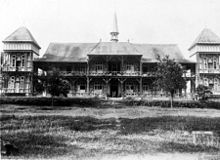Alexis Harbor
| Alexis Harbor | ||
| State : |
|
|
| Province : |
|
|
| Coordinates : | 5 ° 3 ′ S , 145 ° 29 ′ E | |
| Residents : | 27,420 | |
| Time zone : | AEST (UTC + 10) | |
|
|
||
Alexis port (also Alexis Harbor) is a small coastal town about 25 km north of Madang in Papua New Guinea .
history
The Russian explorer Nikolai Miklucho-Maklai was based in Konstantinhafen on Astrolabe Bay from June 27, 1876 to November 10, 1877 . He stayed in Bilbil for a long time and from there discovered a port, which he named Grand Duke Alexis Port after Alexei Alexandrovich Romanov, Admiral General of the Imperial Russian Navy .
In 1883 the Russian corvette Skobelew visited the port under Captain Vadim Vasilyevich Blagodarew . The offshore island was named Skobelew Island, today it is called Sek Island.
In 1896 the Steyler missionaries began their missionary work in New Guinea. The mission station Sankt Michael in Alexishafen was founded by them in 1905 and developed rapidly economically, so that the North German Lloyd decided to call Alexishafen with its Reichspostdampfer Manila , after the missionaries had a massive pier for the mooring of the ship to take over the copra from the coconut palm plantations Mission built. This station consisted of a nurses 'station, the episcopal residence, St. Michael's Cathedral, apartments, a catechist school , workshops, machine rooms, the girls' school, the mission hospital, storage rooms and the mission plantings. The city was also the seat of an Apostolic Prefecture .
In 1922 the territory of the Steyler missionaries in the former German Kaiser-Wilhelms-Land was converted to the Apostolic Vicariate. First Vicar Apostolic was Bishop Franziskus Wolf ; on November 24, 1922, he received his appointment and went on a mission.
During the Second World War , the Steyler missionaries had to flee from Alexishafen to protect themselves from attacks by Japanese troops . The headquarters of the mission was completely destroyed by an air raid on September 1, 1943, of the cathedral only remains of the foundations and the outside staircase remained. A memorial with a crucifixion group was built on the old mission cemetery in Alexishafen. Franziskus Wolf found his final resting place in the crypt of the newly built church.
Today there is a health center in Alexishafen, in which Steyler nurses and doctors work.
Industrial zone PMIZ
Alexis port location is a controversial project to create a 300 million US dollars expensive industrial zone Pacific Marine Industrial Zone (PMIZ). The government of Papua New Guinea, together with the World Bank , the People's Republic of China and Japan, is planning to build ten new tuna factories with port facilities, warehouses and workers' accommodation on the former territory of the mission station .
Many local landowners of the Sek, Rempi and Kananam ethnic groups from the villages around the area are against the Pacific Marine Industrial Zone . The aim of the PMIZ is to fish the region's rich tuna deposits. The villagers, who depend on fishing, fear for their livelihood. Industrial overfishing would exhaust the tuna stocks within a few years. Unskilled, inexpensive workers from other Asian countries would take over the work in the factories.
The exploitation of the fishing grounds would also have consequences for the regional ecosystem. The Madang Lagoon has an unusually rich biodiversity . The Environmental Impact Assessment published in June 2010 by the Department of Environment and Conservation of Papua New Guinea (DEC) found two endemic fish species and two globally endangered fish species to be found in the area. Two species of globally threatened turtles have also been sighted in the project area. The lagoon is home to three endangered mammal species. On land, four animal species are listed as species in need of protection by the Washington Convention on CITES in Appendix 2, including the Rainbow Lorikeet and the Eclectic Parrot .
The official groundbreaking ceremony for the PMIZ project took place in June 2009.
Individual evidence
- ↑ Hans Minssen: Machine attention! Linen go! - Ten years leader of the imperial mail steamer "Manila" , Scherl Verlag, Berlin 1944, pages 124–129
- ↑ Alexishafen , In: Heinrich Schnee (Ed.): Deutsches Kolonial-Lexikon . Volume I, Leipzig 1920, p. 717.
- ↑ The remains of the bombed-out cathedral of Alexishafen ( page no longer available , search in web archives ) Info: The link was automatically marked as defective. Please check the link according to the instructions and then remove this notice. Australian War Memorial, Campbell
- ↑ Missionsfriedhof Alexishafen ( page no longer available , search in web archives ) Info: The link was automatically marked as defective. Please check the link according to the instructions and then remove this notice. Pacific Wrecks
- ↑ Memorial at the Alexishafen cemetery ( Memento of the original from September 24, 2016 in the Internet Archive ) Info: The archive link was inserted automatically and has not yet been checked. Please check the original and archive link according to the instructions and then remove this notice. Photographers Direct
- ↑ Second exhumation and final burial of the bishop , Association for the Promotion of Mission Studies, New Journal for Mission Studies, Volumes 24-25, 1968
- ↑ PMIZ homepage ( page no longer available , search in web archives ) Info: The link was automatically marked as defective. Please check the link according to the instructions and then remove this notice.
- ↑ PMIZ Watcher: EIS paints a terrible picture of PMIZ impacts ACT NOW! PNG

